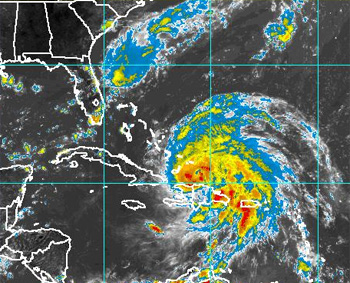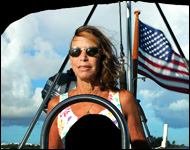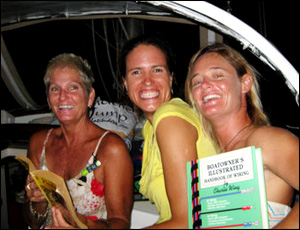 |
| Hurricane Irene – August 23, 2011 – 21:45 UTC – Photo Goes East |
As readers prepare for hurricane Irene, we are re-printing a story that Pam Wall wrote about going through Hurricane Dennis in the Abacos.
In it she shares a list of things to have aboard to help you prepare as well as a checklist of preparations to make as a hurricane approaches.
Several years ago we were in the Bahamas for our summer vacation. It was early July and we had not been worried about hurricanes at that time of year.
But, good old Bertha didn’t look at her calendar! We were in White Sound, Green Turtle Cay, in the Abacos at that time. Our family of four plus our dog were aboard, and while we were all a bit frightened, we were proud that we had stayed aboard our boat, Kandarik, a Freya 39. Bertha did her best to ruin the islands, but thankfully there was not much damage.
And now, just two weeks ago, we were again in the Abacos, and as our luck would have it, Hurricane Dennis came out of nowhere and tested our wits again.
The National Hurricane Center (NHC) in Miami predicted it would go to the East of the Abacos. When the Northeast seventy-plus knots of wind died for about fifteen minutes and the wind veered to the Southwest with a vengeance, we knew the NHC was wrong and the eye of the hurricane had come over us. And this was our vacation!
Getting prepared for a hurricane
 |
| South Pacific: S/V CARIBEE riding comfortably in 80 knots after hurricane Rene passed – Photo provided by Cheryl Baker |
I feel now that we are experienced in getting our boat and ourselves prepared for the forces of a hurricane. The things we will always have aboard when cruising during the tropical storm season are essential for the safety of the boat and all aboard.
I have made a small list of essentials that may be useful for others:
Hurricane List
- Galvanized shackles of every size, your chain size and larger, and of course, seizing wire
- Extra 50 foot lengths of chain, the size you use for your anchors and larger
- Anchor swivels
- Extra heavy duty line ¾” and larger preferably Megabraid, 100 and 200 foot pieces
- Heavy duty galvanized or stainless steel thimbles
- Assorted different style anchors (at least three plus a larger storm anchor)
- Jerry cans for extra fuel and water
- Lots of lashing lines
- Hand held VHF
- Hand held depthsounder for sounding secure anchorages as well as what is ahead of and behind the boat
- Raw water strainers that are easy to clean for the unusually dirty water following a hurricane
- Sheepsfoot knife for fast cutting of lines to be kept in the cockpit
- SSB or Ham Radio and/or battery powered AM/FM radio for local forecasts
- Masks, snorkels, fins, and if possible filled SCUBA tank for setting anchors and securing moorings under the water
- Good recording barometer (really fun to see AFTER it is all over!!!)
- Lots of towels and heavy duty chafe gear
- Ventilator caps for all vents and dorades
- Dogs for all hatches and ports
- Big roll of Duck Tape
- Dacron sticky back tape for instant sail repairs
- Good sturdy dodger that can safely be left up in the strongest of winds
- Anchor weights
- Extra long anchor snubbers
- Batteries for flashlights, radios etc.
- A really good washer and big dryer for cleaning up everything after it is all over!! Ha, Ha, I wish!!!
This looks like a lot of equipment, but it really isn’t. And most of it you would have already. If you don’t have all this aboard, you could be caught short when you need it the most. Believe me! We saw so many people looking for this equipment when it was too late or unavailable. It is so easy to think ahead and make provisions. Once we knew that Dennis was going to be a threat to us, we started looking for a secure anchorage. This can sometimes be difficult when everyone else is doing the same thing.
So, start getting yourself a safe place as soon as you can.
Beat the crowds and find yourself a place with as few other boats as possible as the real danger can be others breaking free and crashing into you!
Here is another small list that makes it easy to prepare for the worst:
Safe List
- Take ALL sails down, mainsail, genoas, mizzens, ALL, flake them and stow below deck
- Take all Bimini Tops, awnings, weather cloths, etc. off the frames and lash the frame securely
- Take all downwind poles off the mast and secure as low on the deck as possible
- Tape the snap shackles with duck tape and pull to top of the mast (don’t forget to leave one to be able to retrieve the rest!)
- Lash all the halyard falls to the mast. Nothing should be able to whip in the wind (and it will if left unlashed)
- Take any undeployed anchors off the bow rollers where chafe could occur; lash the anchors on deck where they could easily be deployed if needed during the hurricane
- Cap all ventilators
- Stow EVERYTHING on deck down below. If it can get loose on deck and cause damage it will!
- Use a combination of chain at the bottom and line to the boat for anchors and mooring lines. All chain does not have enough stretch, and all line could chafe on the bottom. Mooring weights are a great help and Megabraid seems to have the best stretch and chafe resistant capabilities for these extreme conditions.
- Secure all lines through smooth chocks, to strong cleats, and use fair leads. Heavy-duty snatch blocks are great if the lead from your chock to the cleat isn’t fair.
- Do not rely on the windlass for securing anchors on chain or line
- Check every unattended boat around you for secure mooring (that will be your biggest worry!)
By the time Dennis came upon us, we had secured everything as best we could. During the 48 hours of very strong winds, we were constantly checking for chafe and adjusting the lines to the best advantage.
After the eye passed over us at about 4 am (naturally it would be in the dark!) we had only a couple of minutes to make sure we would be ready for the 180 degree windshift.
We actually had to swim out another couple of mooring lines to different mooring blocks when the shift came. It’s easier to swim under water than take a chance on a flipping dingy above the water. Two of our anchors were useless, as the eye had been predicted to pass well to the East.
Ready for the storm
As the storm approached us, we were all ready for her in the Eastern Harbor of Man-O-War Cay in the Abacos. There were about 25 unattended storage boats in the harbor on permanent moorings.
Only five boats had crews aboard. Funny how close we all became. It was like one big family in different rooms, all with the same fears and problems, and all willing to help one another should the need arise. We were continuously on the VHF radio checking on each other. Truly, we became the closest of friends during that 48 hours!
The pelting rain and gusting wind began about 12 hours before the eye passed over us.
We went for a walk to the windward side of the island to see the ocean. It was blowing about 55 to 60 knots and even though we had difficulty walking against this wind, the view we had of the raging sea was spectacular. The normally peaceful lagoon inside Man-O-War reef was a tempest of gusting wind, huge seas, no visibility, and enormous breaking surf on the coral lined beach.
And the hurricane had not even yet arrived. Our anchorage was still quite calm behind the hills with the wind very sporadic with short-lived gusts to 50 knots.
 |
 |
 |
At dark the full fury of the storm came upon us.
Why does it always come at night? Cockpit watches and chafe patrols kept us awake. The anemometer registered over 70 knots and I know it was blowing more than that for some of the time. Kandarik would heel over in the stronger gusts, then shake herself back onto an even keel. The noise on deck was deafening as the wind whistled through the rigging. We could hear the shotgun sounds of a loosed roller furling genoa on the boat up the harbor from us. Below in the cabin it was difficult to talk to one another over the sound of roaring wind. While it did not rain very much, only spitting at times, the wind driven seawater poured over the boat like a wild shower. Even in the dark we could see the gusts literally lift the harbor water up and send it whirling across the surface.
We could not sleep. I was on the Ham Radio every few minutes getting updates, and giving the National Hurricane Center our barometric pressure, wind speed and direction. It was fun being part of their network.
At about 3:30 a.m. the wind stopped. It was so weird!
We rushed up on deck; there was the loom of the full moon, and no wind. I got on the radio and reported this to the Hurricane Center in Miami. I was asked to go on deck and give every detail of the conditions. Now, at last they knew exactly where the eye was. Within minutes the wind made its dramatic change that confirmed the location of the eye.
If it was blowing hard before the eye passed us, well, let me tell you, it blew even stronger on the backside of the storm!
And now the pouring pelting rain came. Sheets of rain smothered the boat. Even higher gusts of wind came more frequently and lasted longer. The barometer plummeted in its final dive, and seemed to stay at its all time low forever.
As dawn finally came we realized we needed more lines out to windward.
The only solution was for Andy to swim to where we thought there was another mooring block. There I was on the bow, holding on as the wind tried to tear my hands from the bow pulpit, watching my husband swimming in the half-light of dawn, trying to secure another line to a mooring in front of us! I remember not being able to see anything as the stinging rain bit into my skin like a million needles.
I was really worried about Andy and was so relieved when he resurfaced near the boat. It was a struggle for him to get back aboard. He laughed at my worried expression and told me how peaceful it was below the surface of the water. He was lucky to have found the mooring.
The hurricane force winds lasted another twelve hours.
We saw two boats tear loose from their moorings and smash into other boats before finally ending up on the shore. There was nothing anyone could have done to save them, as the wind was far too strong for a dingy to survive without flipping over. I have never seen such rain. Blankets, not sheets, of water were thrown over us. Dennis must have liked the Abacos, as he was so slow to move on.
Our poor barometer must have hated my eyes peering continuously at it hoping for the much-desired rise in pressure.

It was late evening of the second day that it finally calmed down to 35 or 40 knots. The rain continued, but there was a definite ease in the wind. By Sunday morning it was all over, calm and peaceful again. The seas outside the island continued to rage for several more days as Dennis insisted on churning up the ocean to the North.
But, for us, the show was over.
This article appeared on Pam Wall’s blog
Less than 10 days later, Kandarik encounters hurricane Floyd!!!! Read the story! (Pam Wall’s blog).
About Pam Wall
 Pam sailed around the world in a 7-year adventure with her husband and young children before finding her important niche as West Marine‘s Outfitting Manager.
Pam sailed around the world in a 7-year adventure with her husband and young children before finding her important niche as West Marine‘s Outfitting Manager.
In this role Pam has done much to support cruisers, both new and experienced, as she has through the many seminars she presents at boat shows across the country (including Women and Cruising seminars) and the sailing she teaches annually at Women on the Water Week in the British Virgin Islands.
Pam’s website is www.PamWall.com.
Read also on this website
- Earthquakes & tsunamis – Part 2: lessons learned in Samoa, by Amanda Neal: Suggestions for preparing for and responding to earthquake and tsunami alerts.
Read some of Pam Wall’s contributions to Women and Cruising:
- Pam WALL Answers 12 Questions about Sailing as a Family aboard Kandarik
- Pam Wall: What I like Most about Cruising
- Pam Wall: Galley Advice from a Circumnavigator
More information (external links)
- Hurricane Floyd, by Pam Wall: “Dennis came and went with no damage to our boat Kandarik except for our frazzled nerves. We never dreamed we would encounter another hurricane in less than ten days!”
- National Hurricane Center: The National Hurricane Center website provides detailed location and forecasting of tropical storms and hurricanes in the Atlantic, Caribbean Sea, Mexico and the Eastern Pacific.
- Hurricanes in Baja: Fire Drills and the Real Thing, by Gwen Hamlin
Have you weathered a hurricane or tropical storm?
Share your experience.
Email kathy@forcruisers.com or leave a comment below.


What a great account, Pam! I laughed when I read “it finally calmed down to 35 or 40 knots”. I’m in Tasmania right now sailing on a tall-ship for a few months. The other day we were motor-sailing home to Hobart up the D’entrecasteaux Channel when we hit a squall that was blowing a steady 25-30 knots with frequent gusts to 35..and even hit 42 for a second. At one point the winds died down a bit to 20 knots and the captain turned to me and laughed out loud, commenting that 20 knots felt like pleasant light breeze. It was true, too! Funny how quickly one becomes acclimated to those strong winds. Well done!